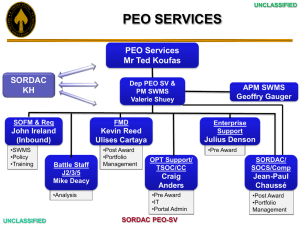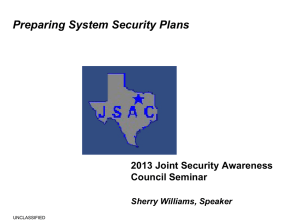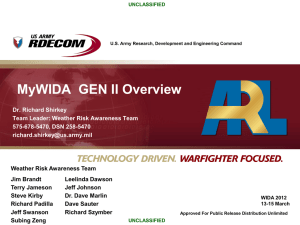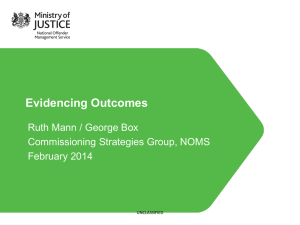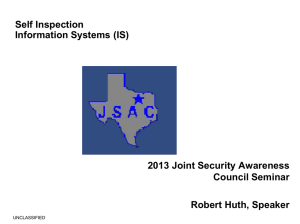Power Point
advertisement
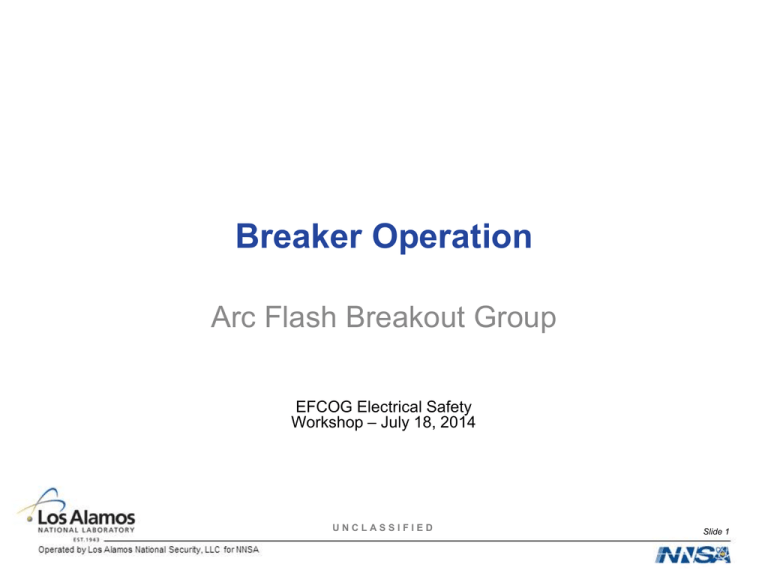
Breaker Operation Arc Flash Breakout Group EFCOG Electrical Safety Workshop – July 18, 2014 UNCLASSIFIED Slide 1 Breakout Group Objectives • Develop a position statement on 2015 NFPA 70E breaker operation task – Analyze equipment condition statement – Analyze basis for no PPE • Develop a Best Practices for breaker operation – During normal operation – During a tripped condition – After maintenance, modification and/or initial installation UNCLASSIFIED Slide 2 Proposed Table 130.7(C)(15)(A)(a) Task Equipment Condition Arc Flash Hazard Normal operation of a circuit breaker (CB), switch, contactor, or starter All of the following: • The equipment is properly installed • The equipment is properly maintained • All equipment doors are closed and secured • All equipment covers are in place and secured • There is no evidence of impending failure No One or more of the following: • The equipment is not properly installed • The equipment is not properly maintained • Equipment doors are open or not secured • Equipment covers are off or not secured • There is evidence of impending UNCLASSIFIED failure Yes Slide 3 Bounding conditions from Table 130.7(C)(15)(A)(b) • Panelboards or other equipment rated up to 600 V – Maximum of 25 kA short-circuit current available; maximum of 0.03 sec (2 cycles) fault clearing time; working distance 18 in. • 600 V class MCCs – Maximum of 65 kA short-circuit current available; maximum of 0.03 sec (2 cycles) fault clearing time; working distance 18 in. – Maximum of 42 kA short-circuit current available; maximum of 0.33 sec (20 cycles) fault clearing time; working distance 18 in. • Metal-clad switchgear, 1 kV through 15 kV – Maximum of 35 kA short-circuit current available; maximum of 0.25 sec (15 cycles) fault clearing time; working distance 18 in. • And More… UNCLASSIFIED Slide 4 Impact of Equipment Conditions • The equipment is properly installed • The equipment is properly maintained • All equipment doors are closed and secured • All equipment covers are in place and secured • There is no evidence of impending failure UNCLASSIFIED Slide 5 What does properly maintained mean? • *The phrase properly maintained, as used in this table, means that the equipment has been maintained in accordance with the manufacturer’s recommendations and applicable industry codes and standards. • According to: – NFPA 70B. Recommended practice for electrical equipment maintenance & – ANSI/NETA standard for maintenance testing specifications for electrical power distribution equipment and systems. • Perform maintenance minimum of every 5 years UNCLASSIFIED Slide 6 What does properly maintained mean? Continued… • Maintenance includes: – – Breakers: Inspection for installation, condition, and housekeeping Insulation resistance testing Trip test through breaker (current injection) Millivolt drop test Cleaning Loose connection evaluation (torque or infrared) Exercise mechanically Disconnects & other Switches: Inspection for installation, condition, and housekeeping Insulation resistance testing Contact resistance testing across blocks and fuse holders Cleaning Loose connection evaluation (torque or infrared) Exercise mechanically UNCLASSIFIED Slide 7 Our position on maintenance • NFPA 70B is recommended standard for performing electrical maintenance. – Each site will establish a program based on the recommended standards and manufacturers recommendations to fit their needs. • Our position is if the equipment has been maintained per the sites maintenance program than the equipment would be considered properly maintained. UNCLASSIFIED Slide 8 Our position on Table 130.7(C)(15)(A)(a) and (b) • The 2015 NFPA 70E task table for breaker operation has very good intentions with regards to risk assessment, but it was the breakout groups opinion that the allowance to operate breakers without PPE, even if properly installed, maintained, and with no evidence of impending failure, would allow operations that should require the use of Arc Flash PPE to adequately protect the worker. • As a result the breakout group determined a threshold where No PPE under the equipment conditions should be allowed. UNCLASSIFIED Slide 9

